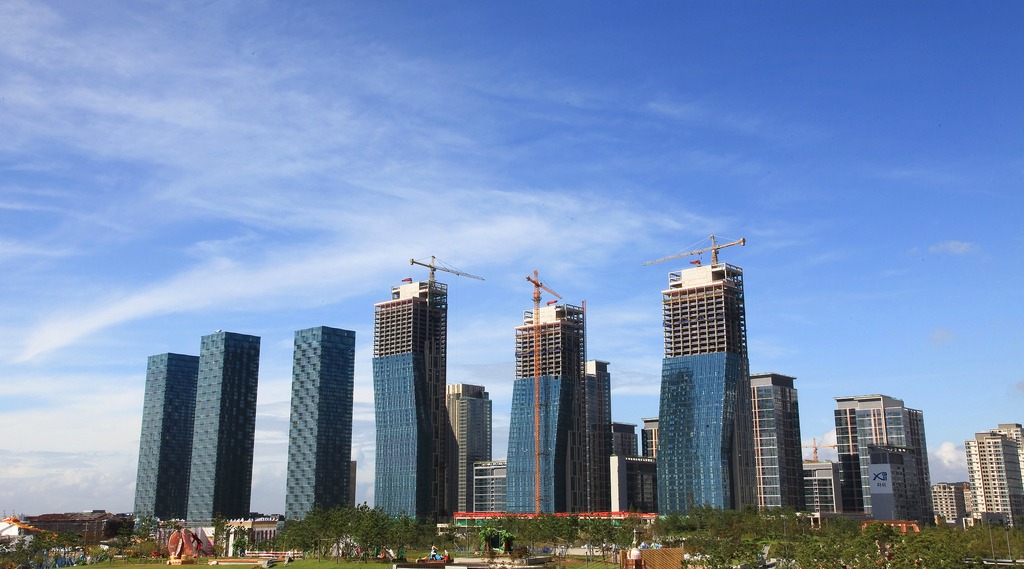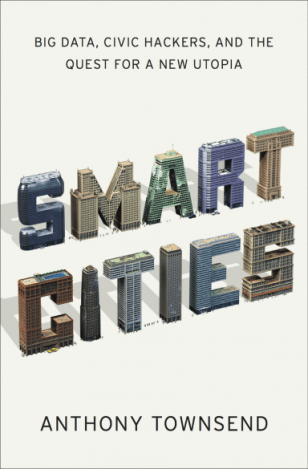
Michele TraviersoYou can tell this is a city of the future because its buildings are a little crooked.
In 2009, the city of Songdo, South Korea, scored $47 million from Cisco Systems to construct its urban plumbing the digital way. Today, roads outfitted with sensors track traffic patterns. An electrical grid equipped with more sensors monitors the movements of residents. The heartbeat of Songdo, translated into millions of sensor readings, is relayed to large data centers in the city’s center where, the thinking goes, tech-savvy government managers will discern patterns about the flow of parcels and people — when cars are on the road, when folks are traveling in elevators — and eventually find a way to choreograph a seemingly endless sequence of individual actions into a dance designed for optimal efficiency.
Welcome to the Smart City, a land where the internet is a friend always, and electronic interconnectivity between infrastructure and people is the rule. Anthony Townsend, director of urban research at New York University’s Rudin Center for Transportation, extols the virtues of such a place in his new book, Smart Cities: Big Data, Civic Hackers, and the Quest for a New Utopia. Townsend envisions a modern City Upon a Hill, a beacon of orderliness diligently watched over by computers and expertly administered by public officials guided by a contemporary, high-tech version of Adam Smith’s Invisible Hand. If water, sewage systems, and gas were the utilities that powered the rapid growth and expansion of cities worldwide through the late 19th and much of the 20th century, the network will transform the cities of the 21st, he says.
The underpinning for Smart Cities rests mainly on one data point: Cities are rapidly becoming the homes for most of the Earth’s human population. By 2050, seven out of 10 people will live in a city. To manage urban growth, mitigate economic collapse, and stave off environmental catastrophe, Townsend reckons, cities must get smart.
But an argument that relies heavily on the migratory patterns of people over the last half-century to make an appeal for the Smart City appears to forget just that: people. Therein lies the weakness of Townsend’s main premise. Smart Cities, like many well-intended technocrats, puts great faith in technology’s ability to transform our cities, but it’s unclear whether the companies building out “smart infrastructure” are doing so with all a city’s residents in mind.
Songdo, just outside of Seoul, is Townsend’s most dramatic example of what it means for cities to incorporate technology into the fabric of urban life. But there’s also Rio de Janiero, where an operations center keeps tabs on the garbage truck fleet via GPS. In Zarazoga, Spain, “citizen cards” unlock bicycles from bikeshare stations and connect people to wifi along that town’s Digital Mile.
These are modest, if intriguing, beginnings. And the closest to a definition Townsend gets is as curious as it is unappetizing: Smart cities are those “powered by business technology” that will help human kind “build our way back to balance.”
No wonder our shepherds in the march toward intelligence are the global conglomerates that have flattened the world we’re now supposed to reengineer. The heroes in this utopian quest are Cisco Systems, Siemens, and IBM — the three companies that stand to benefit most from smart infrastructure. Townsend estimates that cities around the globe will spend around $100 billion on the coming transformation.
To his credit, Townsend largely eschews techno-fetishism, and puts forth some compelling, practical propositions. Imagine America’s aging electrical grid, upgraded with the proper equipment, learning the peak hours for household electricity use, then preserving power, as well as the planet’s depleting resources. Or consider a future where citizens can vote directly on city council legislation via smartphone, lending their voices to public policy decisions.
At times, however, Smart Cities hews to the doctrine of Silicon Valley disruption, shellacked for these purposes with a patina of civic necessity. We can remake the world, each new line of code ensuring that all interactions — between businesses, between government, between people — are purely utilitarian in scope, since anything else would be superfluous, or erroneous, or excessive.
The question Townsend seems to be asking is if a truly new civic paradigm can emerge from cities going all in on smart infrastructure. But he acknowledges that the companies building a smarter planet (as the IBM tagline goes) “are making choices about technology, business, and governance, with little or no input from … citizens themselves.”
Under the mantra of “smart,” cities cease being shifting, evolving organisms and instead become programs to write and codes to crack. Grassroots advocacy by and for people who cling to the very bottom rungs of society doesn’t matter when everyone is a number, and every thing an equation. And as digital dependency — digital serfdom, to borrow language from David Gelernter’s Mirror Worlds — transcends people’s ability to post a Facebook update and invades their ability to, say, sign up for affordable health insurance or communicate with a self-absorbed technocracy, forgotten will be a class of people who are already divorced from the promise of a better life.
Consider an anecdote Townsend includes about Eduardo Paes, mayor of Rio de Janiero. In 2010, flooding triggered mudslides through the slum villages occupying the hillsides above Rio’s city center. Hundreds died, and thousands more became homeless. Paes called in IBM, and constructed Rio’s Operations Center to house a weather forecasting and disaster management system designed by Big Blue, something he hoped would help the city avoid another such disaster by predicting it before it ever happened.
At a TED conference in Long Beach two years after the flooding, Paes ended his talk with a videoconference to the Operations Center. Digital maps showed a spotless weather forecast. GPS indicated where the city’s garbage trucks were. And live video of downtown Rio shortly before midnight — transmitted by a camera mounted to one of the city’s buses — showed that city streets were all clear.
Rio de Janiero looked awfully smart. But its streets were empty. And the slums are still there.
In the end, Townsend’s blueprint for reengineering our cities is muddled and wishy-washy. The book ends with Townsend assuring readers that the smartest city is the one they live in, a hopeful nadir for those cities still lacking their own operations centers, digital miles, or smart grids.
Admittedly, rebuking technology and those who invoke its promise is exceedingly easy in an age when a messaging app that will help future undisciplined politicians share untraceable junk pics turns down $3 billion. Technology has done, and will continue to do, good things for our world.
But there are limits, and lest whole cities are subsumed into two categories – those that think, and those that don’t — we’ll need to make sure that people, not machines, are at the heart of the endeavor.
Correction: Because even Homer nods, it’s incorrect to say, as I did in the original version of this piece, that Townsend forgets the poor in his book. Indeed, he dedicates an entire chapter to “Have Nots,” and reflects throughout the book on how to make smart technology useful and accessible to poor people. Just one example: He notes that civic apps contests tend to serve a “connected elite.” Townsend is mindful of the “technological divide,” but his faith in our ability to transform tech to serve the underserved comes off as a touch over-optimistic, given our experience so far, and the examples he provides in his book.




